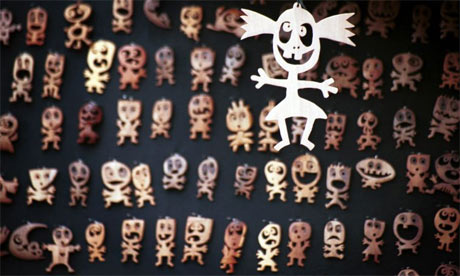
Of all fantastical life-forms, golems are my favourite. Originating in Jewish folklore, they are kneaded, like Adam, out of mud or other inanimate matter, and enlivened by words – often holy writ, either written on their foreheads or placed within their mouths. Erasing one letter from the Hebrew legend "emet" on a golem's brow changes its meaning from "truth" to "death", destroying its bearer.
Golems are compelling to writers both because they rely explicitly on words to give them life and because they're simultaneously more and less than human – super-strong, sub-normally mute, manlike in form but crude and unformed in outline. Eternally patient and silent, these looming claymen have a greater dignity than sinister, prattling living dolls or self-moving puppets. But they are not without menace – left to themselves, they will continue to dig, to build or to fetch, as ordered, until they bury or undermine their task. Sometimes, too, they run amok.
Michael Chabon's 2001 Pulitzer-winner, The Amazing Adventures of Kavalier and Clay, is full of golems. The legendary Golem of Prague, created by Rabbi Yehudah Loew in the 16th century to defend the Jewish community against "blood-libel" (the charge that the blood of Christian children was used in the Passover ritual), has since been lying dormant in an attic, ready to come again at need, like a river-mud King Arthur. In 1939, as Chabon tells it, the golem's enormous coffin provides the means for young Jewish artist and escapologist Josef Kavalier to escape German-annexed Prague for the States. There he creates a paper golem, The Escapist, a Nazi-defeating comic-book costume hero through whom Joe channels his rage and sorrow at being unable immediately to rescue the rest of his family.
Early in the novel, Chabon coins a delightful term: a mishearing of "wish-fulfilment". "Wishful figment" is about the perfect way to describe a golem; weighed down with its creator's wishes, it is indisputably a figment, a creature made by others' agency, to fulfil others' plans. But they may also develop eccentricities and wishes of their own.
These secret golem yearnings put Terry Pratchett's Feet of Clay high on my list of best-loved Discworld novels. The golems of Ankh-Morpork are valued property, since they can work in the most unsavoury conditions without sleep, food or wages. Out of their own clay, though, and in their rare off-duty hours, the disenfranchised claymen have furtively sculpted themselves a king. Meshugah is a repository for its makers' hopes, with which they overload it in the form of beseeching, teaching, hectoring words. When the king, literally half-baked and maddened by its plethora of instructions, breaks the golem taboo against taking human life, many of its creators destroy themselves in agonies of dusty remorse, allowing themselves to be smashed by steam hammers or blasted in furnaces. Only Dorfl, the tannery golem, is able to destroy Meshugah – freed, re-baked and given a tongue, Dorfl becomes Ankh-Morpork's first clay policeman and "ceramic atheist".
Giving a golem speech – allowing a creature animated and sustained by words the opportunity to answer back – is unusual, not to say blasphemous. Laura, the teenage heroine of Elizabeth Knox's duologue The Rainbow Opera/The Dream Quake, creates a wishful figment for herself in the shape of a Nown, or golem sandman, to whom she also gives a voice. The wishes with which Laura lades him are apparent – aware of oppressive secrets at her unhappy society's highest echelons, she needs her father's support, but he is badly injured and traumatised, and cannot help her. In her golem, she creates the perfect hybrid of father and lover: strong and fast enough to carry her out of danger; incorruptibly loyal but making no intrusive demands (although when she gives Nown speech and independence, he becomes more unpredictable and difficult to handle). Nown is one of the most appealing fictional golems I've come across – his metamorphosis, in a furnace-like burning building, from sand to rough, bubbled glass, is joyful and extraordinary.
Golemetry, cut loose from the traditional constraints of mud, dust or sand, is also a notable branch of thaumaturgy in China Miéville's rebellious, seething New Crobuzon and its environs. In Iron Council, Judah Low (his name a homage to the creator of the Prague golem) learns the rudiments of mud animation from a species called the stiltspear, shortly to be overrun and destroyed by his employers, the encroaching TransContinental railway. He develops his arcane knowledge through the making of crude little mudmen, until he can create golems from materials like light, shadow, and ultimately time, a skill he devotes to the service of rebellious railway workers, enabling them to remain free aboard a "perpetual train" liberated from the TCR. Although, unlike Pratchett's, his golems have no personality, independence or speech, Low pours his own strength into them, suffering through them when they meet destruction, so the reader remains on tenterhooks whenever they fight.
Golems fascinate me because they hold up a distorting mirror to humanity; they're a godsend to authors, a wordless comment on the temptations and pitfalls of playing God. Does anyone have any more mudman recommendations for me?

